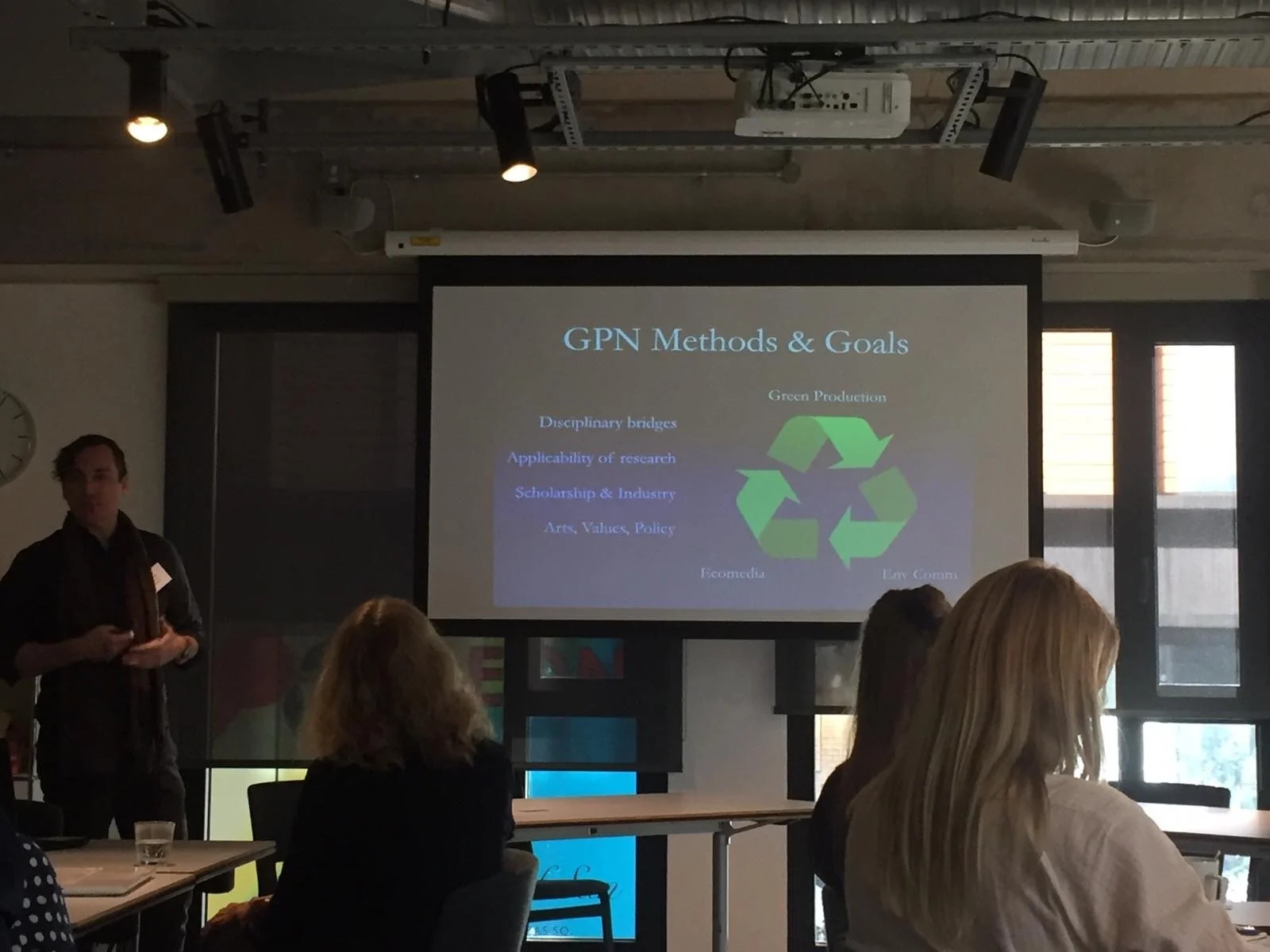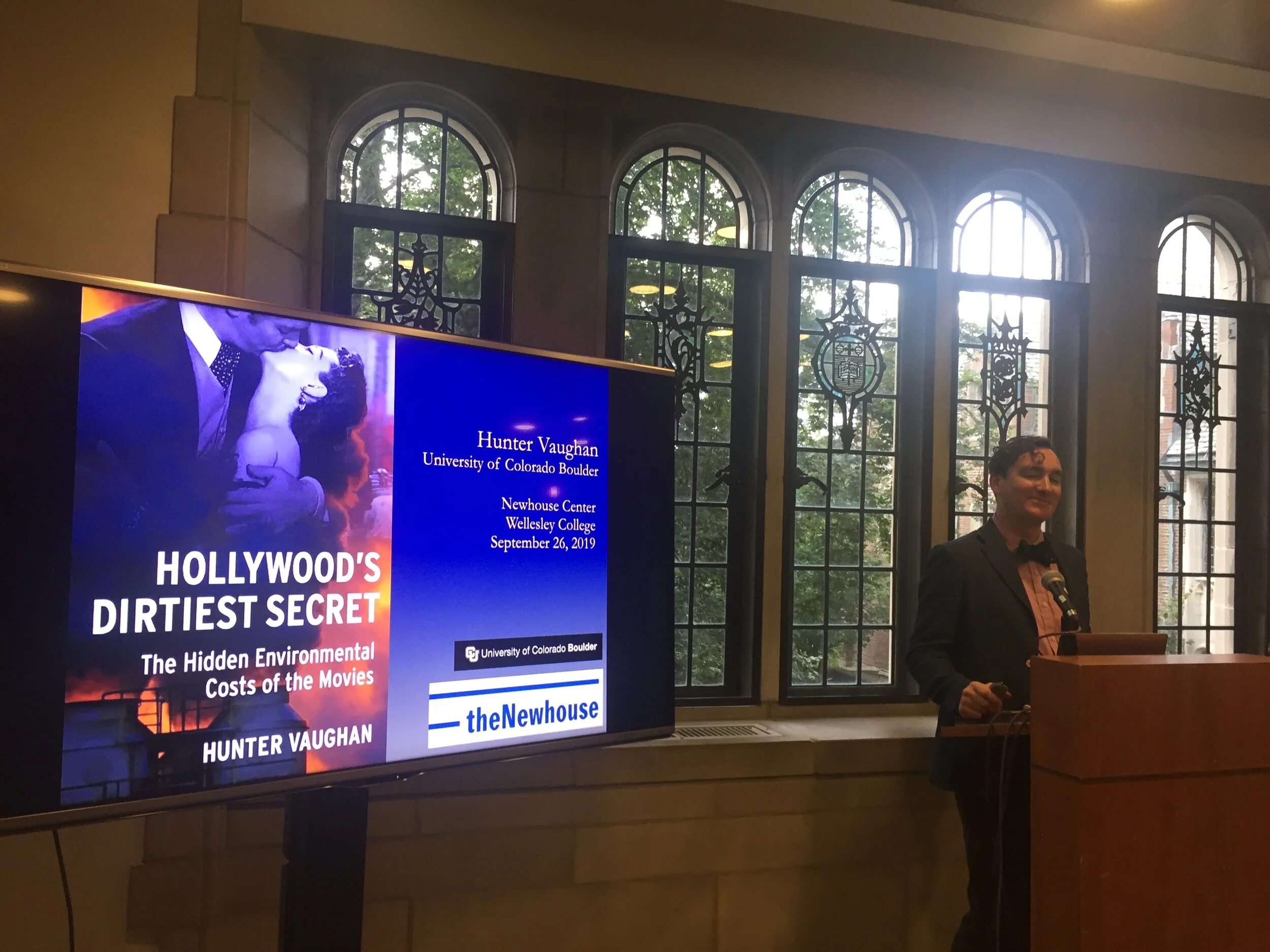books, talks, and research projects
hollywood’s dirtiest secret
columbia university press, 2019
“In an era when many businesses have come under scrutiny for their environmental impact, the film industry has for the most part escaped criticism and regulation. Its practices are more diffuse; its final product, less tangible; and Hollywood has adopted public-relations strategies that portray it as environmentally conscious. In Hollywood’s Dirtiest Secret, Hunter Vaughan offers a new history of the movies from an environmental perspective, arguing that how we make and consume films has serious ecological consequences. Bringing together environmental humanities, science communication, and social ethics, Hollywood’s Dirtiest Secret is a pathbreaking consideration of the film industry’s environmental impact that examines how our cultural prioritization of spectacle has distracted us from its material consequences and natural-resource use. Vaughan examines the environmental effects of filmmaking from Hollywood classics to the digital era, considering how popular screen media shapes and reflects our understanding of the natural world. He recounts the production histories of major blockbusters—Gone with the Wind, Singin’ in the Rain, Twister, and Avatar—situating them in the contexts of the development of the film industry, popular environmentalism, and the proliferation of digital technologies. Emphasizing the materiality of media, Vaughan interweaves details of the hidden environmental consequences of specific filmmaking practices, from water use to server farms, within a larger critical portrait of social perceptions and valuations of the natural world.”
Check it out here
Research projects
Global green media production network, 2019-2021
I am PI with Pietari Kääpä (University of Warwick) on the Global Green Media Production Network (GPN), a two-year network grant funded by the UK Arts and Humanities Research Council (AHRC) providing a platform for collaboration between academic research and industry practice. The aim is to facilitate dialogue the humanities and social/environmental sciences and media industry professionals to generate better understanding of mutually beneficial means of collaboration to facilitate more environmentally responsible and sustainable media production initiatives. The GPN explores how environmentally sound media practices are connected to local cultural values, media industry and economic policy dynamics, and climate change challenges. The Network is a symbiotic support system, at once learning from, synthesizing, and offering assistance to film and television professionals, environmental advocates and policymakers, and emergent scholars and artists in the screen arts, intended to connect and provide humanities-based support for stakeholders in media production and environmental activism, including (but not limited to): scholars, media professionals, NGOs, policy advocates, scientists, science communicators, and activists. . This grant will begin with a research and practice symposium for European and UK stakeholders, then move to pilot studies in South America, India, and Hong Kong. The GPN model is designed to be scalable as these pilot studies form the basis for a larger second-stage grant extending to sites including the Middle East, Africa, and the Indigenous North, as well as adjacent grant work to expand to education and film industry practices in the U.S. The objectives and deliverables for the GPN include:
· a global network, connected by a permanent online site and database connecting all stakeholders, to share industry, policy, and analysis documents
· policy initiative pamphlets for industry and business practice, advocacy strategies, and environmental media activism
· PhD student development
· book collection published by a major academic publisher
Presenting the interdisciplinary methods and goals of the GPN.
The GPN’s first workshop, London 2019, bringing together leading scholarly figures in environmental media studies, ecocrticism, and communication with industry experts in green production from across Europe and the UK.
–
critical lab, 2019-present
The CRITICAL Lab (Community Research IniTiative for Interdisciplinary Collaboration And Learning) is an interdisciplinary, multisite workgroup focused on social justice research that is grounded in the intersection of digital learning, climate change, and family migration. Building its first study around the diverse student body at International Studies Charter High School (ISCHS) in Little Havana, Florida, this project continues important innovative educational research (previously sponsored by the National Science Foundation) that explored how youth and families learn to tell stories about family migration and urban space with data visualization tools and builds on previous iterations that investigated science communication and storytelling. We collaborate and seek grant funding from organizations such as the National Geographic Society for education field research, environmental media scholarship, and arts-based community action to support community self-advocacy and cultivate future community leaders.
–
sea-level rise environmental messaging reception studies, 2017-present
I act as the environmental media and ecocriticism expert for a reception study of short-form seal level rise messaging in South Florida, funded by a Pilot Program grant from the University of Miami’s Center for Communication, Culture, and Change. I broke down the 50 most-viewed short-form (<4mins) seal-level rise videos on YouTube and built a formal typology and genre taxonomy based on dozens of audio and visual practices, in conjunction with four connotative genres of engagement and address: Neutral, Optimistic, Fearful, and Humorous. Choosing samples of each genre coded for disparate stylistic patterns, we ran ten videos by a student focus group to perform qualitative and quantitative reception analysis. We then ran a Qualtrics survey that screened four of videos (the most impactful of each genre) to do a cross-referential study of how these genres and viewer engagement are constructed through interrelated formal patterns, and how both these patterns and the genres play out according to the socioeconomic identity of viewers.
–
rachel carson center fellowship, 2017
Member of a four-person team given a fellowship to develop a journal on media and the environment. This grew into the formation of two journals: Journal of Environmental Media (Intellect Books, eds. Meryl Shriver-Rice and Hunter Vaughan) and Media+Environment (UC Press, eds. Alenda Chang, Adrian Ivakhiv, and Janet Walker).
Boston Film and Media Speaker Series, Newhouse Center, Wellesley College
I co-founded and am co-Editor-in-Chief (with Meryl Shriver-Rice) of the Journal of Environmental Media (Intellect Books) - click the link to check it out!
“‘The Anthem Handbook of Screen Theory’ offers a unique and progressive survey of screen theory and how it can be applied to a range of moving-image texts and sociocultural contexts. Focusing on the ‘handbook’ angle, the book includes only original essays from two primary sources: established authors in the field and new scholars on the cutting edge of helping screen theory evolve for the twenty-first-century vistas of new media, social shifts and geopolitical change. It is at once inclusive, applicable and a chance for writers to innovate and really play with where they think the field is, can, and should be heading.”
(Edited with Tom Conley, Anthem Press, 2018)
“In Where Film Meets Philosophy, Hunter Vaughan interweaves phenomenology and semiotics to analyze cinema's ability to challenge conventional modes of thought. Merging Maurice Merleau-Ponty's phenomenology of perception with Gilles Deleuze's image-philosophy, Vaughan applies a rich theoretical framework to a comparative analysis of Jean-Luc Godard's films, which critique the audio-visual illusion of empirical observation (objectivity), and the cinema of Alain Resnais, in which the sound-image generates innovative portrayals of individual experience (subjectivity). Both filmmakers radically upend conventional film practices and challenge philosophical traditions to alter our understanding of the self, the world, and the relationship between the two. Situating the formative works of these filmmakers within a broader philosophical context, Vaughan pioneers a phenomenological film semiotics linking two disparate methodologies to the mirrored achievements of two seemingly irreconcilable artists.”
(Columbia University Press, 2013)






